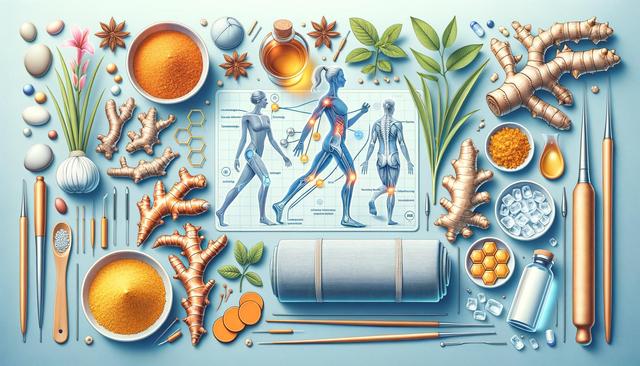Understanding Joint Pain and Its Common Causes
Joint pain can result from a wide range of conditions, including arthritis, overuse, injury, or inflammation. It affects people of all ages, although it becomes more common with age. Osteoarthritis, rheumatoid arthritis, and gout are some of the leading medical causes. However, even repetitive motions or poor posture can lead to discomfort in the joints. Recognizing the root cause of your joint pain is an important step in finding the right natural treatment. For many, natural options can offer significant relief without the side effects associated with some medications.
Common symptoms associated with joint issues include:
- Stiffness, especially after periods of rest
- Swelling and tenderness around the joint
- Reduced range of motion
- Aching or a feeling of warmth in the joint area
Understanding these symptoms can help guide you toward the most appropriate natural treatments and lifestyle changes to manage discomfort effectively.
Diet and Nutrition for Joint Health
What you eat plays a crucial role in managing joint pain. Certain foods have anti-inflammatory properties that may help reduce pain and stiffness while supporting overall joint function. Incorporating more whole foods into your diet is a foundational step toward maintaining joint health. Omega-3 fatty acids, for example, are known to reduce inflammation in the body and are commonly found in fatty fish, flaxseeds, and walnuts.
Consider adding the following foods to your meal plan:
- Leafy greens like spinach and kale for their antioxidants
- Berries and oranges for vitamin C and anti-inflammatory benefits
- Nuts and seeds as sources of healthy fats
- Turmeric and ginger for their natural anti-inflammatory compounds
On the other hand, it’s wise to limit or avoid processed foods, refined sugar, and excessive red meat, as these can worsen inflammation. A well-balanced, nutrient-rich diet supports not only joint health but overall wellness.
Herbal Remedies and Supplements
Several herbs and natural supplements have been studied for their potential to ease joint pain. While results vary from person to person, many individuals find relief using these options alongside other treatments. Turmeric, in particular, has received attention for its active compound curcumin. Known for its anti-inflammatory effects, curcumin may help reduce joint swelling and pain when used consistently.
Other natural supplements worth considering include:
- Glucosamine and chondroitin, commonly used for cartilage support
- Boswellia, an herbal extract known for reducing inflammation
- MSM (methylsulfonylmethane), which may support joint flexibility
- Omega-3 fatty acids from fish oil
Before starting any supplement regimen, it’s important to consult with a healthcare professional, especially if you’re taking other medications or have underlying health conditions. Natural doesn’t always mean risk-free, and professional guidance can help you choose the right options safely.
Physical Activity and Movement Therapies
While it might seem counterintuitive, staying active is essential for managing joint pain. Regular, low-impact exercise helps to strengthen the muscles around your joints, improve flexibility, and reduce stiffness. Activities such as walking, swimming, cycling, or yoga can be particularly beneficial. These exercises are gentle on the joints and promote circulation, which supports the healing process.
Here are a few movement-based therapies that may help:
- Stretching routines to maintain flexibility
- Yoga and tai chi for mobility, balance, and stress reduction
- Water-based exercises to reduce pressure on joints
- Strength training to support joint stability
Consistency is key. Even a short daily routine can make a meaningful difference over time. If you’re new to exercise or unsure where to start, working with a physical therapist or certified trainer can provide personalized guidance that aligns with your needs and limitations.
Additional Natural Therapies for Comfort and Relief
Beyond diet, supplements, and exercise, other natural therapies can complement your approach to managing joint discomfort. Heat and cold therapy, for instance, can provide targeted relief. Applying heat can help loosen stiff joints and improve blood flow, while cold therapy may reduce swelling and numb sharp pain.
Other non-invasive options include:
- Massage therapy to improve circulation and reduce tension
- Acupuncture, which may help stimulate pain-relief pathways
- Topical treatments with natural ingredients like capsaicin or menthol
- Essential oils such as eucalyptus or lavender for calming inflamed areas
Incorporating these techniques into your routine can offer comfort and support your overall treatment strategy. It’s often the combination of several approaches that yields the most consistent and lasting results.
Conclusion: Managing Joint Pain Naturally and Mindfully
Living with joint pain doesn’t have to mean constant discomfort or dependence on medication. A blend of natural treatments—including dietary changes, herbal supplements, physical activity, and supportive therapies—can make a meaningful difference in how you feel each day. These approaches not only target symptoms but also support your long-term joint health. By paying attention to your body, making informed choices, and seeking professional guidance when necessary, you can take proactive steps toward a more comfortable and mobile life.




Leave a Reply